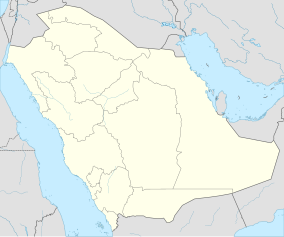| King Salman Bin Abdulaziz Royal Natural Reserve | |
|---|---|
 | |
| Location | Saudi Arabia |
| Nearest city | Sakakah, Saudi Arabia |
| Coordinates | 27°58′11″N 39°12′00″E / 27.96972°N 39.20000°E / 27.96972; 39.20000 |
| Area | 32,296,673 acres (130,700.00 km) |
| Established | 2018 |
| Governing body | King Salman bin Abdulaziz Natural Royal Reserve Development authority |
| ksrnr | |
King Salman Bin Abdulaziz Royal Natural Reserve is located in the north of Saudi Arabia. It is the largest reserve in the kingdom with 130,700 square km area. Within its borders are three protected areas: Al-Khanfa, Al-Tubaiq, and Hurra Al-Hurra. A royal decree was issued in June 2018 to include all three areas under the King Salman bin Abdulaziz Royal Reserve, headed by Prince Abdulaziz Bin Saud Bin Nayef Bin Abdulaziz Al Saud.
The reserve is distinguished by its pristine nature, clean air, geographical and heritage diversity, and rare antiquities, some of which date back to 8000 BC, such as the area of Jubbah and Kilwa.
On November 22, 2022 King Salman Bin Abdulaziz Royal Reserve was officially added to the World Database on Protected Areas (WDPA).
King Salman Royal Natural Reserve Development Authority
King Salman Bin Abdulaziz Royal Reserve Development Authority was established by Cabinet Resolution No. (437) on February 25, 2020, which includes approval of the organizational arrangements of the Royal Reserves Council and the Royal Reserves Development Authority. In addition to the inclusion of the three protected areas (Al-Khanfa, Al-Tubaiq and Hurra Al-Hurra) and the areas between and adjacent to them into a royal reserve (King Salman Bin Abdulaziz Royal Reserve), whose board of directors is chaired by Prince Abdulaziz Bin Saud Bin Nayef Bin Abdulaziz.
Borders
The reserve is bordered with Sakaka governorate and Domat al-Jandal in the eastern, Tabuk to the west, Tayma to the southwest, Hail to the southeast, and the Jordanian border to the north. The reserve is located within four administrative regions, which are Al-Jawf region, Hail region, Tabuk region, and the northern border. Several governorates and villages are located within the reserve borders, the most prominent of which are: Al-Qurayyat and Tabarjal in Al-Jawf region, and Tarif in the northern border region.
Geographical and biological diversity
The reserve is characterized by a tremendous diversity in its geographical nature, as it includes fourteen geographical formations of mountains, plains, plateaus, etc., and includes various valuable minerals.
In biological view the animal and plant diversity in the reserve, the number of animal species in it reaches three hundred species, between rare deer and various wild animals. While there are more than 230 plant varieties of trees, desert flowering plants, and others.
Hurra Al-Hurra
Hurra Al-Hurra is located in the north of the Kingdom of Saudi Arabia with the Jordanian borders, and east of Al-Sarhan valley, with an area of 13775 square km. It includes a number of animals such as the goitered gazelle, the Arabian wolf, red fox, sand fox, striped hyena, rabbit and gerbils. In addition to the plants of tamarisk and bramble, lycium shawii, calligonum planets, and annual shrubs and herbs. It also includes birds such as bustards, golden eagles, curlews and other types of resident and migratory birds.
Al Khunafah
Al-Khanfa is located in the north of the Tayma in Governorate of the Tabuk region. It covers an area of 19,000 square kilometers. It includes a group of hills, reefs and valleys, and a group of animal species live in it, such as the Goitered gazelle, with a small number of Mountain gazelle, foxes, hares, gerbils and types of endemic and migratory birds such as the houbara and the curlew.
Al Tubayq
Main article: Al-Tubayq Natural ReserveTubayq is located in the northwest of the Kingdom with the Jordanian borders, and it covers an area of 12,105 km. It includes a group of mountains, valleys, reefs and khabars, in which acacia and lycium shawii abound. Caribou goat is one of the most prominent animals that live inside the area, along with the goitered gazelle, the Arabian wolf, foxes, the hare and some types of reptiles and endemic and migratory birds.
References
- "المحميات الملكية السعودية", ويكيبيديا (in Arabic), 2022-02-14, retrieved 2022-04-05
- "قائمة الآثار والمواقع الأثرية في السعودية", ويكيبيديا (in Arabic), 2022-03-07, retrieved 2022-04-05
- عام / صدور عدد من الأوامر الملكية وكالة الأنباء السعودية. Saudi Broadcasting Agency (in Arabic). 2018-06-02. Retrieved 2022-12-15.
- "جغرافيا السعودية", ويكيبيديا (in Arabic), 2022-02-04, retrieved 2022-04-05
- "Geography of Saudi Arabia", Misplaced Pages, 2022-03-14, retrieved 2022-04-05
- "Harrat al-Harrah Protected Area". www.ncw.gov.sa. Retrieved 2022-04-05.
- "Al-Khunfah Protected Area". www.ncw.gov.sa. Retrieved 2022-04-05.
- "Al-Tubayq Protected Area". www.ncw.gov.sa. Retrieved 2022-04-05.